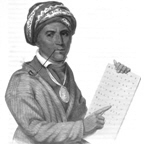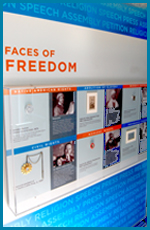Exhibit Guide Home
Exhibits
Introduction
Founding Generation
Founding Documents
You
Be the Judge
Defining Freedom
The Struggle Continues
Faces
of Freedom
Marketplace of Ideas
Censorship: What Is It?
Musical Hit List
Draw
the Line
Resources
Museum Map
Glossary
|

When the Bill of Rights was ratified, many
Americans were excluded from the freedoms it
promised. In the late 1700s, the only people who
could vote were property owners, who were white
men. Women were not considered equal to men, and
married women were expected to be subservient to
their husbands.
Various groups with limited or no rights in
society have used their First Amendment rights
throughout our history. Sometimes they were
successful and other times they were not. In
some cases, expanded freedoms were gained but
the struggle for more rights continues today.
The people who led these movements for freedom
were ordinary people. A school teacher in
California. A pastor at a church in Georgia. A
railway worker in Indiana.
So what made them special? They wanted to be
heard, they wanted rights for their people, and
they all used the First Amendment to fight for
their cause. Their leadership and actions helped
change American history and we still benefit
from their legacy today.
They’re an example to us all that anyone can
make a difference.
 |
Native American
Rights:
Sequoyah
Sequoyah created
the system of
writing for the
Cherokee
language in
1809. It opened
the doors for
widespread
literacy and
education in the
Cherokee nation,
and played a
crucial role in
the fight for
Cherokee rights.
Learn more
back to top
|
 |
Women's
Suffrage: Alice
Paul
Alice Paul
fought for
political
freedom, and
didn’t worry
about who she
offended in the
process. She led
a national
movement for a
constitutional
amendment giving
women the right
to vote.
Learn more
back to top
|
 |
Abolition:
Sojourner Truth
A minister and
commanding
speaker,
Sojourner Truth
escaped from
slavery in 1826
and spent the
rest of her life
fighting for
abolition and
human rights.
Learn more
back to top
|
 |
Civil Rights: Dr. Martin Luther King, Jr.
Martin Luther
King, Jr. was
the spiritual
and political
leader of the
Civil Rights
movement. Dr.
King powerfully
used his First
Amendment
freedoms of
speech,
assembly, and
religion to
rally support
for the cause of
equality between
races.
Learn more
back to top
|
 |
Workers' Rights: Eugene V. Debs
Eugene V. Debs
organized the
American Railway
Union, the first
industrial union
in the United
States. A
socialist, he
passionately
fought for the
rights of
laborers and
organized
numerous
strikes. Debs
formed the
groundwork for
the early labor
movement and
today still
inspires those
who advocate for
worker’s rights.
Learn more
back to top
|
 |
Immigrants' Rights: Mary Tsukamoto
As a U.S.
citizen of
Japanese
ancestry during
World War II,
school teacher
Mary Tsukamoto
and her family
were unjustly
forced from
their homes and
relocated to an
internment camp.
After her
release, she
gave speeches,
wrote articles,
and petitioned
Congress for an
apology from the
government and
reparations to
those interned.
Learn more
back to top
|
<< Previous
Section
Next section >>
|
Onboard the
Freedom Express

This exhibit features artifacts that help tell the story of several historic individuals who asserted their First Amendment rights to challenge social norms and shape history in the United States. These individuals formed coalitions with others and were part of movements, bigger than themselves, to create change.
|
|
![]()
![]()